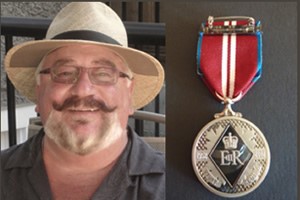The Arthritis Newsletter
Winter 2013A Decade of Volunteering - Gordon Whitehead's Story
By Nadia Prestley
 Gordon, as a member of Consumer Advisory Board (CAB) I’ve had the pleasure of working with you for five years and am delighted that you agreed to this interview. This is your 10-year anniversary with CAB, and I believe our readers will be surprised to discover the extent of your arthritis volunteer/advocacy experience. But before we get started, could you please explain your professional background.
Gordon, as a member of Consumer Advisory Board (CAB) I’ve had the pleasure of working with you for five years and am delighted that you agreed to this interview. This is your 10-year anniversary with CAB, and I believe our readers will be surprised to discover the extent of your arthritis volunteer/advocacy experience. But before we get started, could you please explain your professional background.
I was born and raised in BC and attended the University of British Columbia, where I studied English, history, and Russian. After leaving university, I began working as an actor, but after rather quickly concluding that acting was a sure-fire path to starvation, I abruptly changed course and joined the Canadian Foreign Service. I spent the next 26 years as a diplomat, with overseas assignments in Pakistan, India, Britain, Germany, Poland (I was the Canadian Consul in Poland from 1973-1975), and in Portugal. My specialty was the former Soviet Union and its Warsaw Pact Allies. I served on the Canadian Delegations to the Helsinki Treaty Negotiations and was Director of the European Programs Division at External Headquarters in Ottawa. When my arthritis worsened, I eventually had to leave External Affairs (as the department of Foreign Affairs was then named). I then moved to Victoria in early 1992 where, attached to the Deputy Premier’s Office, I worked for the next two years as Director of Immigration Policy for the Province of BC. In 1994, I was appointed by Cabinet to a judgeship on our Immigration and Refugee Board in Vancouver, and I then moved to Vancouver and worked on the Board for the next 8 years—until my retirement in 2002. My job involved the assessment of claims to asylum in Canada submitted by potential refugees and I wrote legal judgments on my decisions. Looking back, I feel I was very lucky in my work—I had very interesting jobs over a period in time when doing those jobs was especially challenging, interesting and rewarding.
Arthritis is the leading cause of disability in Canada! You have rheumatoid arthritis (RA), a chronic condition that can have a negative impact on many aspects of a person’s life, including the workplace. Were you able to continue working after your RA diagnosis?
My RA came right out of the blue and ironically, struck me in the middle of a canoeing trip to Algonquin Park. At the time, in 1976, I was stationed in Ottawa, in between overseas assignments. My left knee suddenly became swollen, red, and painful, and then my hands reacted the same way. I had no idea what was happening to me. Several weeks later, my joints settled down again, after I’d been put on a high daily intake of aspirin. I knew nothing about the disease then, and, of course, this was long before the Internet and the easy access to information that we enjoy today.
Like many people, I incorrectly assumed that arthritis was a disease of old age—something I might have to confront in my last decades of life. Treatments in the 70’s were also quite limited. And in stark contrast to today’s approach, the prevailing protocol at the time called for a graduated sort of “arms race” against the disease, starting off with anti-inflammatories (NSAIDS) and then only slowly progressing up the medication chain to the few Disease Modifying Drugs (DMARDS) then available.
I was often sore and fatigued in those early years, but I really didn’t take the disease as seriously as I should have done and I really didn’t appreciate how compromised my joints and my overall health were becoming. Imaging at the time was limited to x-rays, which are not as revealing about early joint damage as are newer forms of imaging or more modern modes of assessment. Looking back, I think I was also in a kind of ongoing denial. And like many people newly diagnosed with arthritis, I embarked on trying all sorts of unproven treatments—apple cider vinegar, copper bracelets, ayurvedic preparations, garlic pills—you name it. None worked for me.
The Foreign Service required that a career diplomat be “rotational” — meaning healthy and robust enough to deal with a lot a wide range of posts and stressful situations. I loved my job and didn’t want to face up to losing it because of poor health. I wasn’t put on gold injections until 5 years after diagnosis, when I really started to become crippled up, although I was often sore and fatigued. Needless to say, though, being constantly on the move between countries with different languages and medical systems was very challenging as was the need to be constantly changing doctors who were unfamiliar with one’s medical history. So eventually, I had to leave the Foreign Service.
I, too, left a job because of the challenges created by RA symptoms. I can’t imagine also facing the challenges of getting proper treatment overseas. How did you manage?
I certainly wish that arthritis had never entered my life. And very often medical facilities overseas were primitive (sometimes non-existent).
When I first went abroad, the age of mass jet travel was just beginning and much of the world was still not much visited, nor was it swamped —as it is now— by international tourism. My first assignment was to Pakistan — then still a place pretty much right out of the books of Rudyard Kipling. It was all a wonderful adventure for me—a chance to see places everyone dreams about visiting. I went everywhere then without hesitation, through the Khyber Pass, into Afghanistan, up into the high Himalayas. I stayed on a beautiful houseboat in Indian Kashmir, adorned with beautiful hand-carved cedar panels; I visited the “Temple of the Tooth” in Kandy, Sri Lanka; met the Dalai Llama; I travelled through the incredible ruins of Angkor Watt in Cambodia and was virtually alone in my explorations in the jungles there. I rode the Maharaja of Benares’ elephant to the fire-lit celebrations of the Ramayana in the Hindu holy city.
But things were also rugged in the life overseas. Getting needed medications inside the Soviet bloc was a real struggle. I left my appendix on an operating table in New Delhi after more or less diagnosing my own condition from a book lent to me by a Danish colleague titled “Be Your Own Doctor”. But I sometimes had wonderful nursing care, and when I was recuperating at home in India, I had my cook-bearer looking after me. It was very much a case of learning to adapt, to roll with the punches and to take advantages of what came your way or to find a creative way to overcome what you couldn’t lay your hands on.
It’s nice to hear that you also had positive experiences regarding hands-on care, and that you were able to take some time away from work to recuperate. You’ve written an article for The Arthritis Newsletter about Workplace Accommodation. Did you seek accommodation from your employers?
Looking back over my working life (and I was fortunate enough never to be unemployed and I was able to retire at the regular age), I don’t feel that I handled my arthritis very successfully in the context of the work place. At least that was so until my later years when I approached retirement and began to need joint replacement surgery. For many of my younger working years, though, I didn’t want to own up to my limitations and I often worked myself to the point of exhaustion (I spring from stoical Scottish roots and like many people with a bit of a hard scrabble background, I was raised to never complain). This was especially the case when I was in the Foreign Service. One was expected to be tough and resilient—it was rather like the army that way. As well, I have an ongoing temperamental aversion to becoming a “health bore”. By that, I mean I didn’t want to turn into one of those tedious people, who, when asked how they are, respond with a detailed litany of infirmities
But later on, I did have to seek workplace accommodation and I did have to take time off for surgery and to request modifications to my work schedule. The general approach I finally settled upon is best encapsulated in the phrase: “explain, don’t complain”. That said, a major problem that confronts most people who have to confront arthritis in the workplace is the woeful ignorance that still prevails about the arthritis diseases themselves. Other major diseases like diabetes or cancer invoke automatic responses of sympathy in others, but arthritis does not —although its impact on an individual’s health can be every bit as devastating as the better-known “scary” diseases.
So people with arthritis face a double burden. They have to deal with the impact of their disease on a personal basis, but in a sense, they also have to be prepared to confront entrenched ignorance about their disease and to learn to act as “health missionaries” who need to educate their interlocutors about the disease and to raise awareness in all sorts of practical situations—and especially in the work place. And it can be hard work to build an understanding of the disease and to sensitize others to its many ramifications.
“A double burden” — I agree Gordon! Few people in my own social circle were aware of the devastating consequences of this disease. Because of this, I worry about those who do not recognise the symptoms of RA and may postpone seeing a doctor — we now know that an early diagnosis and quick, effective treatment can limit joint damage and can increase chances of remission.
Gordon, you were awarded the Queen’s Diamond Jubilee Medal this year. Congratulations! You’ve had an impressive career history and volunteer history; for which were you honoured?
The medal was for my volunteer work in arthritis. I often joke that when you retire and you indicate you are free for volunteer work, you will quickly hear the same sucking noise that is made by your kitchen garburator!! Volunteer opportunities very quickly seek you out.
In my case, I first became involved in a program called “Patient Partners in Arthritis” soon after I retired. That was a hugely valuable program that trained persons with arthritis to interact with health care professionals. Patient Partners volunteers were given intensive training in the anatomy of joints in the human body and carried out structured demonstrations to medical students, allied health care providers and community-based physicians. The goal was to increase their skills and effectiveness in examining, diagnosing and treating people with arthritis. The program was based on the principle that arthritis is a chronic condition and people living with it are often the most knowledgeable about many aspects of the disease.
Soon after that, I became involved with the planning for the 2005 Ottawa Summit Meeting on Standards for Arthritis Prevention and Care. The Summit Meeting was a major initiative designed to galvanize the whole arthritis community—- consumers, care givers, involved agencies and organizations— in drawing up a set of national guidelines for preventing, diagnosing, and treating the whole family of arthritis diseases. The effort was spearheaded by an organization then titled the “Alliance for a Canadian Arthritis Program” (ACAP). ACAP was an umbrella organization that was intended to capture all the various voices and players—individual and organizational—that then comprised the Canadian arthritis community. The underlying intention was to devise a vehicle that would allow the community to bring a unified voice and a coherent, agreed-upon set of priorities to discussions with the different levels of government in Canada.
The four Co-Chairs of ACAP were individuals who were (and who continue to be so) very prominent figures in the Canadian arthritis community: Dr. John Esdaille, Cheryl Koehn, Dr. Diane Mosher, and Dr. Gillian Hawker. After the Summit meeting, ACAP worked energetically at implementing the standards for prevention and care that the meeting had produced and Dr. Diane Mosher and I became the two co-chairs of the post-Summit ACAP organization (an entity which is now known, more simply, as “The Arthritis Alliance”).
This was a very demanding undertaking and one that kept me very busy for the following three years. It provided me with many wonderful personal opportunities, such as meeting people, exposing myself to many emerging sources of information, accumulating invaluable knowledge from peers, researchers, health care providers, and unparalleled opportunities for participation in knowledge exchanges. In a nutshell, it permitted me to exchange my “victim hat” for a “participant hat”. Dr. Diane Mosher was simply wonderful to work with at ACAP, as were so many of the other dedicated principals who ran with the agenda developed collectively by the members of the Alliance. I can’t go over in detail all the projects we worked on with the Alliance community over the period of my involvement, ultimately leading to the development of what is titled “The Arthritis Framework”, but I would encourage anyone wanting to have more information about the background and current work of the Alliance to consult its website at: http://www.arthritisalliance.ca/home/ I believe my Queen’s Jubilee Medal was awarded me largely for my work with the Alliance and I am grateful to the Arthritis Society for having nominated me for that signal honour.
What motivated you to volunteer your time to arthritis research and advocacy?
I guess what initially drove me was the basic need I felt to better understand and deal with my disease. But in the process of confronting my own ignorance, I gradually became progressively aware of what a huge impact the arthritis diseases have on the Canadian population and on our medical system and our economy, as a whole. I also discovered how little money was being spent on research into arthritis in comparison to other major chronic diseases. I wanted to do some small part in improving that situation. I have always a great respect for the scientific method of acquiring knowledge and for the huge advances that science has enabled us to make in treating and controlling diseases. But like many consumers, I suspect, I hadn’t really had first-hand exposure to the world of medical research. The time I spent on the Consumer Advisory Board (CAB) of the Arthritis Research Centre of Canada (ARC) was enormously engaging and enlightening for me. It opened my eyes to a whole world that I knew next to nothing about.
Your diverse, 10-year involvement has certainly provided you with valuable insights into the world of patient participation in arthritis research and advocacy.
I don’t know if I have any special insights but I have made many discoveries since taking up arthritis volunteer work. First, I have been hugely impressed with the many dedicated researchers, healthcare providers, and thoughtful, engaged consumers that we have in our community. It’s a treasure trove of talent and commitment. Second, I have become a very firm believer in the worth of consumer involvement, and especially the value of the collective efforts made by our consumers to drive through reforms in health care and to raise public awareness about arthritis. In many tangible ways, arthritis consumers have set the pace for meaningful activism for other disease agencies and groups. Third, I have acquired enormous respect for the work of our researchers—it is very hard work, necessary and invaluable work, carried out under pressing deadlines and often with uncertain funding. These people are true heroes.
Lastly Gordon, your volunteer “adventure” has been fascinating … any surprises?
Some!! I did not by any means fully understand how complex and multi-layered our Medicare system is; how intricate are the many areas of interaction within it. It takes some time to get a handle on that. I didn’t really appreciate how difficult it is for researchers to get a grip on an ongoing, reliable flow of funding, nor did I appreciate how heavy is the burden imposed upon them by constantly having to apply for grants on very tight deadlines—the process reminded me of the uncertainties I faced undergoing auditions for roles as a actor. But what I liked more than anything else and what I hadn’t really anticipated experiencing was the enormous richness of the relationships that volunteering helped one to develop and enjoy among fellow consumers and health care professionals. We have so many wonderful people trying to move our community forward.




















































